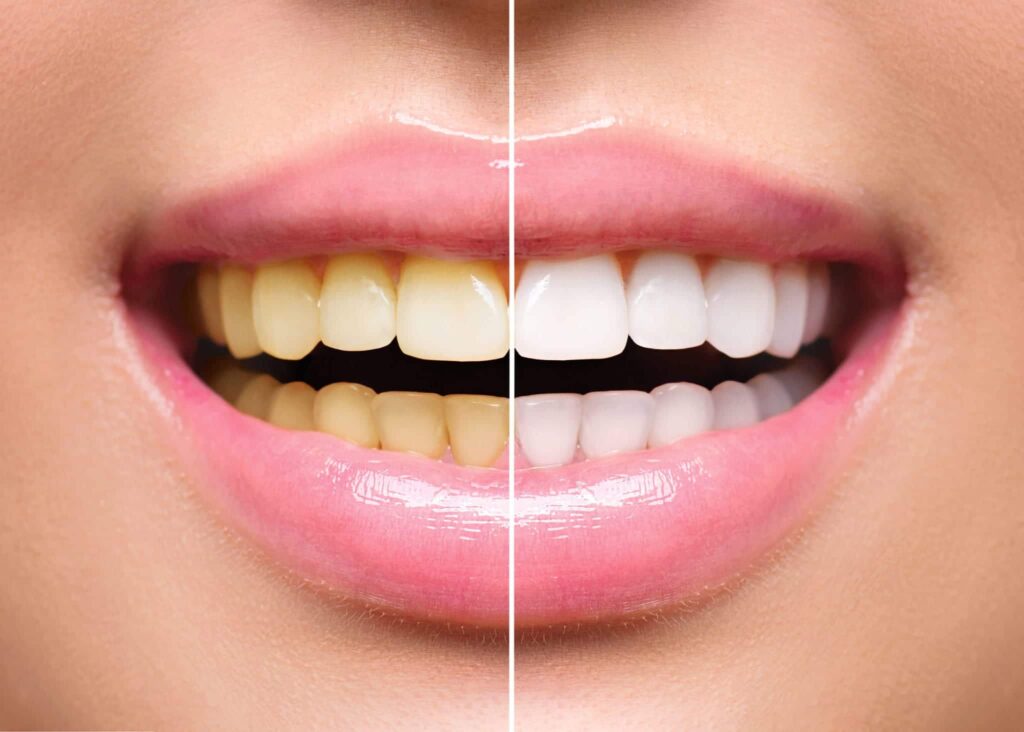Smoking and vaping are known to pose significant risks to your overall health, but their impact on oral health is often overlooked. From yellowing teeth to serious diseases like oral cancer, the consequences of these habits can be severe and long-lasting. Understanding how smoking and vaping harm your mouth can motivate you to make informed choices and seek healthier alternatives. Here, we’ll explore how each habit affects your oral health, highlighting the differences and similarities between smoking and vaping.


1. Staining and Discoloration
How Smoking Affects Your Teeth: Cigarettes contain tar and nicotine, both of which contribute to yellow or brown stains on teeth. The porous nature of tooth enamel means it can easily absorb these substances, resulting in a stained appearance. This discoloration is not only cosmetic but can also affect your confidence and willingness to smile.
How Vaping Affects Your Teeth: While vaping does not involve tar, it often contains nicotine, which can still lead to staining. Although the effects might be less severe compared to smoking, they are still significant enough to be noticeable over time. Some flavored e-liquids can also contain ingredients that contribute to staining or even weaken enamel.
Prevention Tips:
- Consider professional teeth cleaning to remove surface stains.
- Use whitening toothpaste and practice excellent oral hygiene to minimize discoloration.
2. Increased Risk of Gum Disease
Smoking and Gum Health: Smoking is a leading cause of gum disease (periodontal disease). It reduces blood flow to the gums, which impairs their ability to heal and fight infections. Smokers are more likely to experience symptoms like swollen, red, and bleeding gums, which, if untreated, can progress to more severe stages involving gum recession and tooth loss.
Vaping and Gum Health: While vaping may be marketed as a “safer” alternative, it’s not free from oral health risks. Studies have shown that nicotine—whether from cigarettes or e-cigarettes—constricts blood vessels, reducing blood flow to the gums and hindering proper oxygenation. This increases the risk of developing gum disease over time.
Prevention Tips:
- Regular dental checkups can help catch gum disease early.
- Quit or reduce smoking/vaping to improve blood flow and promote gum health.


3. Oral Cancer and Pre-Cancerous Conditions
The Link Between Smoking and Oral Cancer: Smoking tobacco exposes your mouth to a cocktail of carcinogenic chemicals. According to the Oral Cancer Foundation, smokers are six times more likely to develop oral cancer than non-smokers. This type of cancer can affect the tongue, cheeks, lips, and other areas of the mouth.
Is Vaping a Safer Option?: The long-term effects of vaping are still being studied, but early research indicates that it might not be as harmless as once believed. Certain e-cigarettes produce harmful by-products such as formaldehyde, which is a known carcinogen. While vaping has yet to be definitively linked to oral cancer at the same rate as smoking, its risks cannot be ignored.
Prevention Tips:
- Conduct regular self-examinations for unusual patches or sores in your mouth.
- Schedule annual oral cancer screenings as part of your dental checkup.
4. Dry Mouth and Bacterial Growth
Smoking and Dry Mouth: Tobacco use often leads to dry mouth, which can exacerbate bacterial growth. Saliva is crucial for washing away food particles and neutralizing acids in the mouth. A lack of saliva leads to an increased risk of cavities, bad breath, and gum disease.
Vaping and Dry Mouth: Vaping can also cause dry mouth, as many e-liquids contain propylene glycol, a substance known to attract and retain moisture, leading to oral dryness. Reduced saliva production allows bacteria to thrive, making your mouth more prone to bad breath and dental issues like cavities.
Prevention Tips:
- Stay hydrated and consider sugar-free gum or lozenges to stimulate saliva production.
- Use a mouthwash designed to combat dry mouth.

5. Weakened Enamel and Cavities
How Smoking Impacts Enamel: The combination of smoke, heat, and chemicals can erode tooth enamel, making it more susceptible to decay. Once enamel is weakened, teeth are more vulnerable to cavities and other issues that can require extensive dental work to repair.
Vaping and Enamel Weakness: Although e-cigarettes do not produce the same heat or tar as traditional cigarettes, they still contain substances that can be harmful to enamel. The acidic nature of some flavoring agents can weaken enamel over time, promoting decay.
Prevention Tips:
- Use fluoride toothpaste and mouth rinses to strengthen enamel.
- Limit your exposure to sugary and acidic foods and drinks.
How to Protect Your Oral Health if You Smoke or Vape
Consider Quitting or Reducing Use
The most effective way to protect your oral health is to quit smoking or vaping altogether. Support from healthcare providers, nicotine replacement therapies, and counseling can be beneficial in this process.
Prioritize Regular Dental Visits
Frequent dental checkups are essential if you smoke or vape, as they allow for the early detection of oral health issues. Professional cleanings can help manage staining, while checkups provide an opportunity to catch any problems before they become severe.
Practice Good Oral Hygiene
- Brush twice a day with fluoride toothpaste.
- Floss daily to remove plaque between teeth and along the gumline.
- Rinse with an antimicrobial mouthwash to control bacteria and freshen breath.
Final Thoughts
While vaping may seem like a less harmful alternative to smoking, it still carries significant risks to your oral health. Both smoking and vaping can lead to stained teeth, gum disease, dry mouth, enamel erosion, and potentially oral cancer. Being proactive about your dental care and considering cessation strategies can greatly improve your oral and overall health.
Your smile deserves the best care possible. If you’re currently smoking or vaping, start by consulting with your dentist to understand how these habits are impacting your mouth and discuss ways to mitigate the damage.